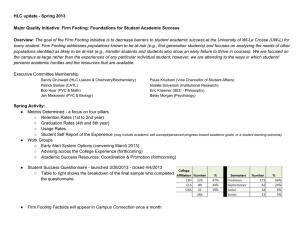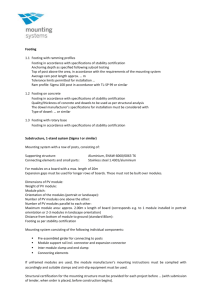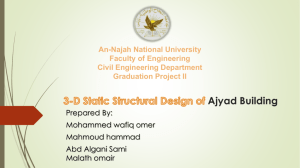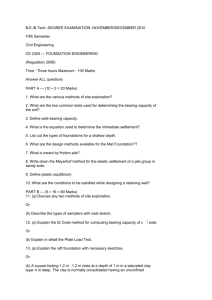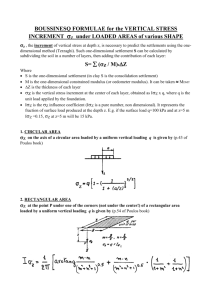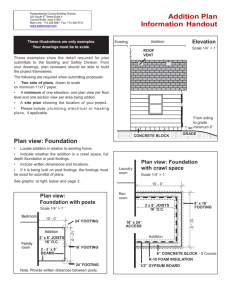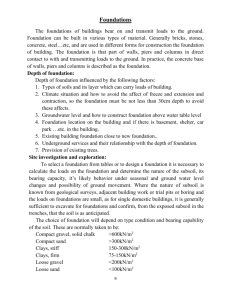Week 13 Foundation Design
advertisement
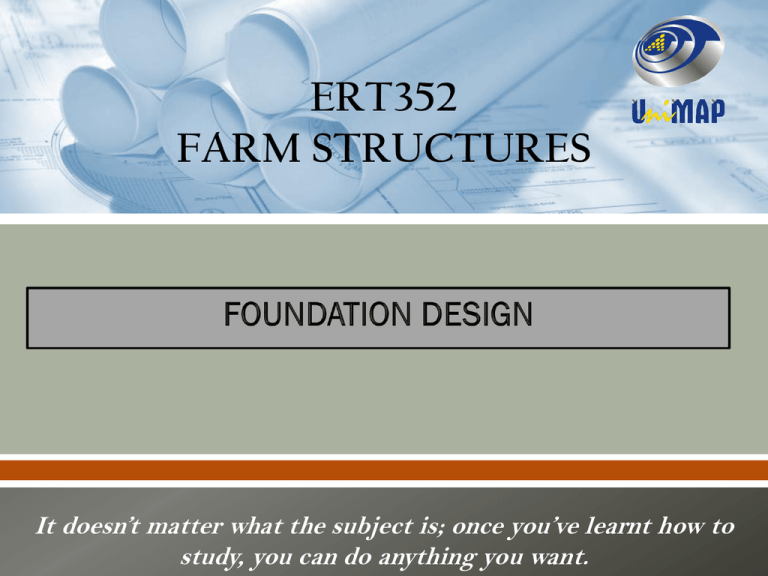
ERT352 FARM STRUCTURES It doesn’t matter what the subject is; once you’ve learnt how to study, you can do anything you want. • Foundation is the part of a structure which transmits the loads from the structure to the underlying soil or rock. • It is usually placed below the surface of the ground. • All soils compress noticeably when loaded and caused the supported structure to settle. • The two essential requirements in the design of foundation are: o The total settlement of the structures shall be limited to a tolerably small amount o The differential settlement of various parts the structure shall be eliminated as nearly as possible. • To limit settlement, it is necessary to transmit the load of the strucutre to a soil stratum of sufficient strenght and to spread the load over a sufficiently large are of the stratum to minimize bearing pressure • Figures below show pressure distribution under footing. • Types of foundation depends on a number of factor such as: o Soil properties and condition, o Type of structure and loading, o The permissible amount of deferential settlement. • The choice is usually made from experience but comparative designs are often necessary to determine the most economical type to be used. • The principal types of reinforced concrete foundation for building are: o Isolated or pad footing o Combined footing o Raft foundation o Strip footing o Strap footing o Pile foundation • Pad Footing o Used to support and transmit the loads from piers and columns o Tend to be the simplest and cheapest foundation type o Used when the soil is relatively strong or when the column loads are relatively light. o Usually square or rectangular on plan, and uniform thickness • Combined Footing o Where 2 columns are closed together or convenient to combined their footing to form a continuous base. o The shape maybe rectangular or trapezoidal. • Strap Footing o Used where the base for exterior column must not project beyond the property line o To restrain the overturning force due to eccentric load on exterior footing • Strip Footing o Commonly used for the foundations to load-bearing walls. o Also used when pad footings for a number of column in line are so closely spaced. o Used on weak ground to increase foundation bearing area. • Raft foundations o A combined footing which covers the entire and supports all the walls and columns. o May consist of a slab of uniform thickness or slab stiffened by beams either above or below the strap or an inverted flat slab floor. o Useful for column with heavy loads or low bearing capacity. • Pile foundations o When a solid bearing stratum (e.g: rock) is deeper than about 3 m below the base level. o Loads are transmitted either to a stiff bearing layer or to soil by friction along the pile. • Design of Pad footing o Thickness and size of footing o Effective depth of pad o Design of flexure • Bending of pad footing o Check for shear • Vertical shear: • at a distance d from the face of column • Ved < VRd,c no shear reinforcement is required • Punching shear • Critical section at the perimeter 2d from face of column o Cracking and detailing requirements • Use rules for slabs in clause 9.3 EC2 • A rectangular pad foundation is required to support a single transferring an axial service load which consists of 600 kN permanent load and 450 kN variable load. Using the data provided, determine the suitable size of pad footing and design the reinforcement required. • Design a rectangular pad footing of uniform thickness for reinforced concrete column of size 300 x 300 mm and carrying an ultimate axial load of 1500 kN and ultimate bending moment 50 kNm
